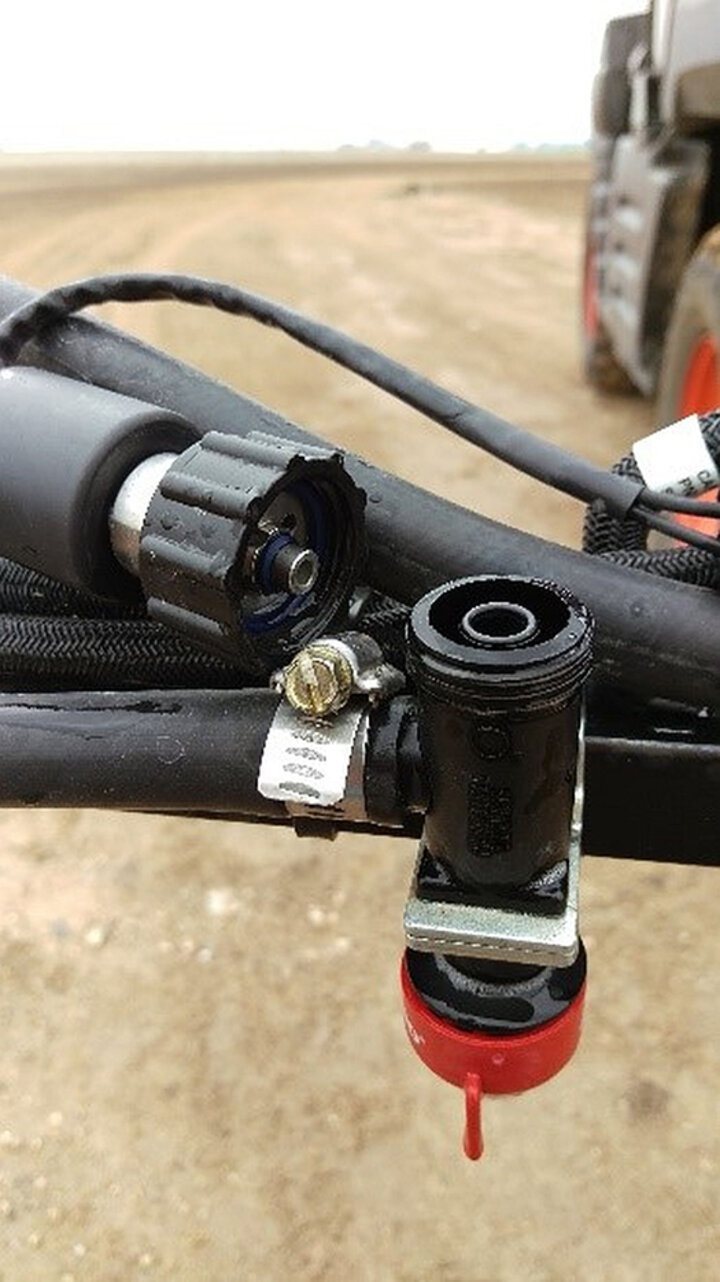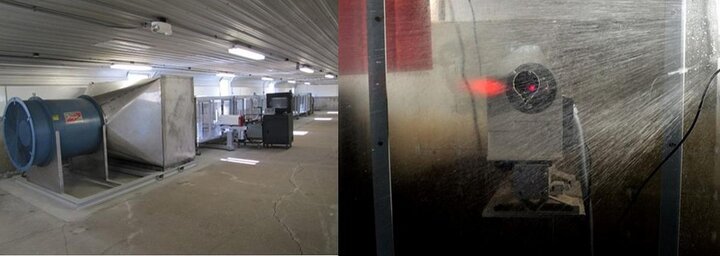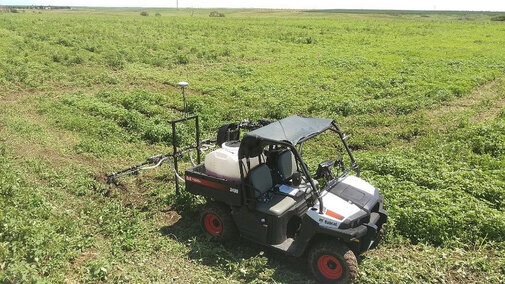
Herbicide drift is a primary concern in production agricultural systems. Off‑target movement of herbicides can lead to excessive damage to susceptible crops, severe yield losses, and animosity among neighbors. Further, profit margins have narrowed in today’s agricultural economy. Yield losses due to crop injury are unacceptable and more precise applications are required to minimize inputs, maximize weed control, and reduce drift potential.
One possibility for increasing application precision and efficiency is using an optimum droplet size throughout an application. Pulse‑width modulation (PWM ) sprayers (Capstan PinPoint®, Case IH AIM Command®, John Deere ExactApply®, TeeJet Dynajet®, and Raven Hawkeye®) can variably control flow by pulsing electronically actuated solenoid valves. A PWM sprayer (Figure 1) can maintain a flow rate across a wide range of sprayer speeds, and minimize overlap with individual nozzle control and flow turn compensation. Moreover, pulsing of the solenoid valves (Figure 2) has a minimal impact on droplet size when using non-air inclusion nozzles, resulting in the ability to maintain an optimum droplet size across an entire field.
Field trials were conducted in western Nebraska to evaluate the optimum spray droplet sizes for several popular, commercially available herbicides: Liberty®, Clarity®, Enlist Duo®, Roundup WeatherMax® plus Clarity®, Ultra Blazer®, and Cobra®. Six targeted droplet sizes (150, 300, 450, 600, 750, and 900 µm) were determined from the Dv0.5 of the measured spray solution. (Dv0.5 represents the droplet diameter such that 50% of the spray volume is contained in droplets of smaller diameter.) To develop the droplet size treatments, combinations of nozzle type, orifice size, and application pressure were tested for each herbicide solution and measured using laser diffraction in the low-speed wind tunnel at the Pesticide Application Technology Laboratory in North Platte (Figure 3). Treatments were applied using a Capstan PinPoint® PWM research sprayer (Figure 1). Applicators can obtain the nozzle type, orifice size, and pressure combinations required to generate specific droplet size classifications from nozzle manufacturer catalogs or the University of Nebraska-Lincoln Ground Spray app available from the Apple or Google Play store.

Liberty®
To learn more about how this system works and best management practices for it, view the author's video How to Better Utilize Pulse-Width Modulation Sprayers. It received first place in the student video competition of the 2016 North Central Weed Science Society.Liberty® (glufosinate) herbicide was applied in 5 and 20 gallons per acre (GPA) at a rate of 22 fl oz per acre near Beaver City in 2016 and Hendley in 2017. Applications were made to 10-inch tall or greater Palmer amaranth (Amaranthus palmeri S. Wats), and no adjuvants were used.
Palmer amaranth control was maximized at 5 GPA with a 600 µm droplet (Extremely Coarse spray classification), and was maximized at 20 GPA with a 150 µm droplet (Fine). However, 90% of the maximum weed control was still achieved with 638 (Extremely Coarse) and 675 µm (Extremely Coarse) for the 5 and 20 GPA carrier volumes, respectively, and would increase drift reduction efforts. Generally across droplet sizes, 5 GPA outperformed 20 GPA to maximize Palmer amaranth control. This is likely due to the fact that no water-conditioning adjuvants such as AMS were used, and more concentrated droplets overcame the hard water antagonism better than less concentrated droplets. If no water-conditioning adjuvants are used in conjunction with glufosinate, a lower carrier volume should be used, but applicators should keep in mind that greater weed control is often observed with the combination of water-conditioning adjuvants and increased carrier volume.
Clarity®
Clarity® (dicamba) herbicide was applied in 5 and 20 GPA at a rate of 8 fl oz per acre near Beaver City in 2016 and Hendley in 2017. Applications were made to 10-inch tall or greater Palmer amaranth, and no adjuvants were used.
Palmer amaranth control was maximized at 5 GPA with a 723 µm droplet (Extremely Coarse) and at 20 GPA with a 525 µm droplet (Very Coarse). However, 90% of the maximum weed control was still achieved with 793 (Ultra Coarse) and 805 µm (Ultra Coarse) for the 5 and 20 GPA carrier volumes, respectively, and would increase drift reduction efforts. This data illustrates even with systemic herbicides, such as growth regulators, there is a critical droplet size and if the spray droplet size increases, weed control is reduced. Alternative precautions for drift reduction other than increasing spray droplet size must be identified and implemented to avoid reductions in weed control. Greater carrier volumes (20 GPA) maintained weed control across a larger range of droplet sizes. Therefore, it is recommended to apply Clarity® with an 805 µm (Ultra Coarse) droplet paired with 20 GPA to maintain weed control while reducing drift potential.
Enlist Duo®
Enlist Duo® (glyphosate + 2,4-D pre-mixture) herbicide was applied in 10 GPA at a rate of 3.5 pints per acre near Big Springs in 2017. Applications were made to 10-inch tall or greater glyphosate-resistant kochia (Kochia scoparia L. Schrad.), and no adjuvants were used.
Glyphosate-resistant kochia control was maximized with a 400 µm (Coarse) droplet size. However, to remain on label, a Very Coarse spray classification must be applied for drift reduction purposes; therefore, greater carrier volumes (above 10 GPA) should be considered to increase coverage and maintain efficacy with larger droplet sizes. The droplet size that maximized weed control with Enlist Duo® was smaller than typically expected for a systemic herbicide. This can be attributed to two factors:
- the kochia population was glyphosate-resistant, so only 2,4-D was active in this scenario, reducing the effective modes-of-action, and
- the leaf structure is small and narrow compared to other weed species such as Palmer amaranth requiring smaller droplet sizes at 10 GPA for retention as compared to other weed species.
This research illustrated numerous factors, such as weed species, herbicide resistance, and carrier volume, that could impact the weed control observed from Enlist Duo® as well as other complex tank-mixtures.
Roundup WeatherMax® plus Clarity®
Roundup WeatherMax® plus Clarity® (glyphosate + dicamba tank-mixture) herbicides were applied in 10 GPA at rates of 22 and 8 fl oz per acre, respectively, near Big Springs in 2017. Applications were made to 10-inch tall or greater glyphosate-resistant kochia, and no adjuvants were used.
Glyphosate-resistant kochia control was maximized with a 400 µm (Coarse) droplet size. Similar to Enlist Duo®, the tank-mixture of Roundup WeatherMax® plus Clarity® required a smaller than expected droplet size to maximize weed control; therefore, greater carrier volumes (above 10 GPA) should be considered to increase coverage and maintain efficacy with larger droplet sizes. The Enlist Duo® pre-mixture and Roundup WeatherMax® plus Clarity® tank-mixture both illustrate the need for alternative drift control methods to increasing droplet size as weed control losses will be observed, even with systemic herbicides, as droplet size passes a critical size.
Ultra Blazer®
Ultra Blazer® (acifluorfen) herbicide was applied in 15 GPA at a rate of 24 fl oz per acre plus 1% v/v crop oil concentrate (COC) near Beaver City in 2016 and Macon in 2017. Applications were made to 10-inch tall or greater Palmer amaranth.
Ultra Blazer® maximized Palmer amaranth control with a 300 µm (Medium) droplet. In fact, the 300 µm droplet size was the only treatment different from the nontreated control. This indicates Ultra Blazer® is very droplet size sensitive and requires a smaller droplet size to maximize weed control even with a carrier volume of 15 GPA.
Cobra®
Cobra® (lactofen) herbicide was applied in 15 GPA at a rate of 12.5 fl oz per acre plus 1% v/v COC near Beaver City in 2016 and Macon in 2017. Applications were made to 10-inch tall or greater Palmer amaranth.
Droplet size did not impact weed control from Cobra®, and across a range of droplet sizes, Palmer amaranth was controlled better than with Ultra Blazer®. This research highlights that even within herbicide sites-of-action (PPO Inhibitors), optimum droplet sizes can vary. For Cobra®, carrier volume affects weed control to a greater extent than droplet size; therefore, it is recommended to use at least 15 GPA with greater droplet sizes to maintain high levels of weed control while reducing drift potential.
Overall, droplet size impacts weed control differently across herbicides and carrier volumes. To optimize spray applications using droplet size, application parameters should be tailored for site-specific weed management approaches to more effectively accommodate the changing application elements such as herbicide, weed species, weather conditions, and geographic location to reduce herbicide inputs and selection pressure for the evolution of herbicide-resistant weeds. It is always important to read and follow label instructions. In these studies, there were a few situations where the label restrictions were not followed for research purposes. It is recommended applications ALWAYS meet label requirements.
In Appreciation
Thank you to the Nebraska cooperators who allowed us to conduct this research on their operations, and thank you to all of the graduate and undergraduate research assistants who helped with data collection. Also, thank you to Capstan Ag Systems, Inc. for providing PWM equipment and support, and to Wilger Industries, Ltd. for providing nozzles used in this research.
For more details on this research and PWM sprayer technology, please visit our website, Pesticide Application Technology Lab or contact Greg Kruger at gkruger2@unl.edu.

